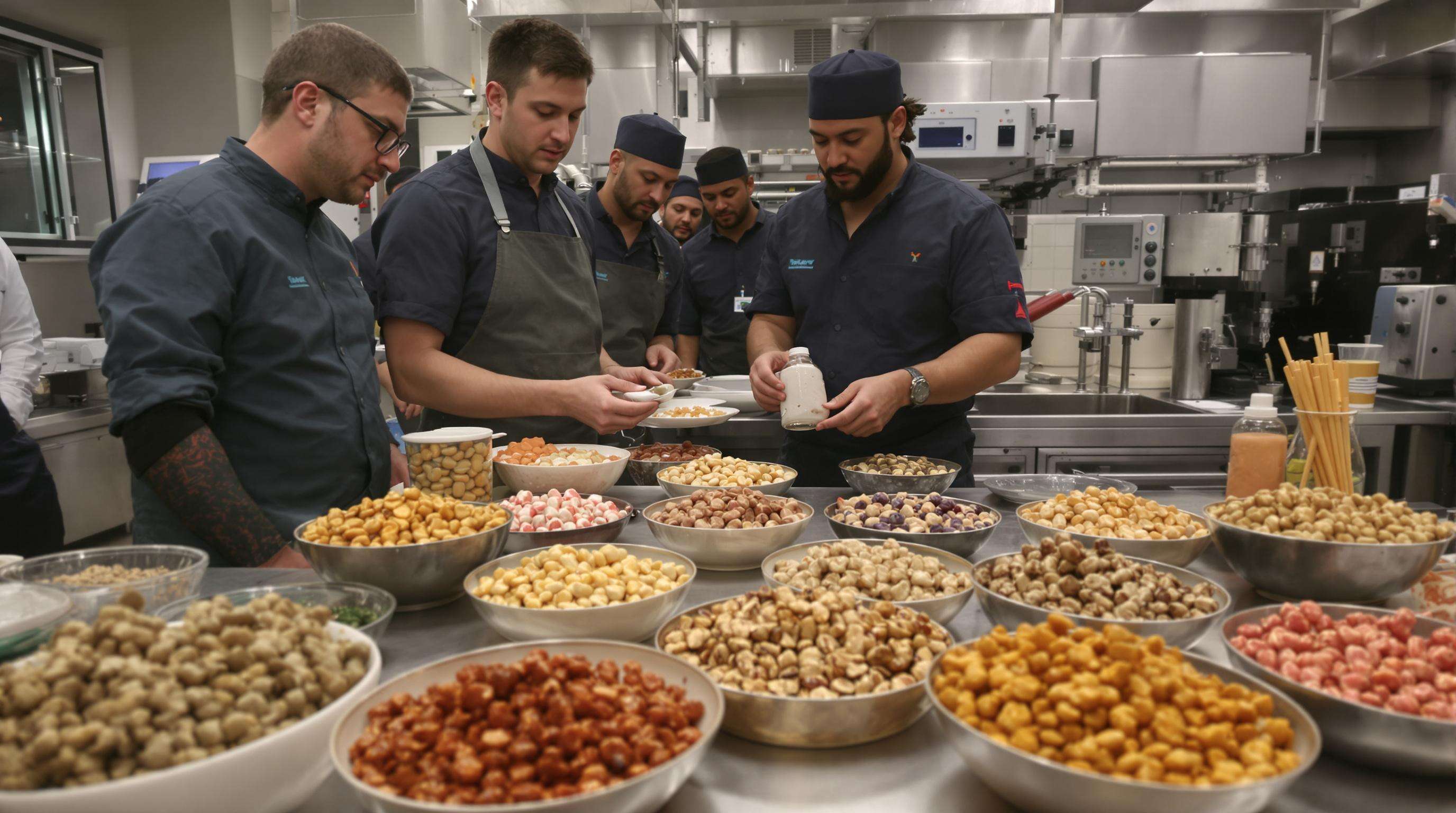More people around the world are turning to coated peanuts lately, especially since about 45% prefer snacks that pack plant-based protein instead of going for regular options according to Ponemon Institute data from last year. These little guys actually deliver around seven grams of protein in just a small serving size of about 28 grams, which fits what many folks are looking for nutritionally without sacrificing on-the-go eating. The change seems most noticeable with younger generations too. Roughly 40 percent of millennials actively hunt down foods made without animal products, and this has definitely helped boost sales both in stores and online marketplaces across the board.
The Asia Pacific region takes the lead in coated peanut consumption at around 58% globally, thanks largely to growing cities and better pocketbooks these days. Latin America isn't far behind though, especially in places like Brazil and Mexico where imports of peanut snacks have jumped nearly 18% compared to last year. Food companies are really stepping up their game when it comes to flavor profiles for different markets. Take Mexico for instance, chili lime is basically everywhere now. Meanwhile down in Southeast Asia, folks seem to love those sweet honey glazed options more than anything else. The market keeps changing as consumer preferences evolve.
The global market for peanut snacks has seen impressive growth over recent years, expanding at around 12% per year between 2020 and 2023. Coated versions are particularly popular right now, taking the lead in this growing sector. Several factors have contributed to this trend. Production costs have dropped significantly in places like Argentina and India where manufacturers can scale up operations affordably. At the same time, trade regulations have become less restrictive across Europe and Southeast Asia. Plus there's been major investment in ports and shipping infrastructure that makes moving these products across continents much easier than before. As a result, we're seeing coated peanuts carve out their own space worth about $2.7 billion dollars inside the larger snack nut market. These flavored treats are beating out plain old roasted and salted options pretty handily these days.

The snack industry is seeing some pretty exciting changes as manufacturers experiment with wild new flavor combinations. Across the Asia-Pacific region, snacks packed with umami flavors like spicy miso and garlic chili have become super popular lately. Meanwhile down in Latin America, people are going crazy for those zesty mixes we see everywhere now, think sriracha lime or even mango habanero. According to the Global Snack Innovation Report from last year, companies launched about 23% more exotic flavors since early 2022. This trend shows how hungry consumers around the world are getting for something different on their taste buds these days.
Brands are fortifying coated peanuts with functional ingredients to meet health-conscious demand. Recent innovations include fiber-rich coatings, plant-based protein isolates, and omega-3 enhancements. These formulations align with the preferences of 74% of snackers who prioritize functional benefits (IFIC 2023), without compromising the satisfying crunch that drives repeat purchases.
| Nutrient Boost | Consumer Benefit | Market Adoption Rate (2023) |
|---|---|---|
| Calcium-Fortified | Bone health support | 18% |
| Probiotic-Infused | Digestive wellness | 12% |
| Antioxidant Blends | Immune system enhancement | 22% |
Artisanal methods such as small-batch honey roasting and single-origin chocolate coatings support premium positioning, with 39% of consumers willing to pay 20% more for handcrafted snacks (Mintel 2024). Cold-pressed coconut glazes and finishes with Himalayan pink salt are increasingly common in luxury snack aisles, helping brands stand out in competitive markets.

Peanuts with coatings pack around 7 grams of plant based protein in each serving and contain those good for the heart monounsaturated fats too. That makes these little nuts pretty smart pick for anyone watching what they eat. A recent study from IFIC in 2024 showed that nearly 56 percent of Gen Z folks actually skip full meals for snacks instead. These coated peanuts fill right in there where people want something quick but still nutritious. When someone eats both protein and fiber together, it keeps them feeling energized longer throughout the day. No wonder why gym goers and people running from meeting to meeting find them so useful.
Food manufacturers have started swapping out those synthetic additives for real stuff that actually does something useful. Take turmeric for coloring and beetroot powder packed with antioxidants as good examples. The food industry has pretty much moved away from traditional coatings these days, going with high oleic peanuts instead because they last longer on shelves without needing those bad hydrogenated oils everyone hates. According to some research done last year, around two thirds of people shopping for snacks want to see ingredients they can pronounce at home. This preference is pushing companies toward creating mixes with things like sea salt, various roasted spices, and those fresh smelling cold pressed citrus oils that give products that extra zing without all the chemical nonsense.
Plain peanuts don't have any natural sugars, but when they get coated, people start questioning those extra sweeteners. Big name companies are getting creative these days. Some now offer dark chocolate covered peanuts sweetened with stevia instead of regular sugar. This version has about 40% less sugar compared to traditional milk chocolate coatings. Others experiment with fermented fruit extracts that taste like caramel but skip the refined sugars altogether. Packaging now clearly states under 5 grams of added sugar per ounce, giving shoppers better information to decide between their sweet tooth cravings and managing blood sugar levels in the long run.
Companies keep changing their flavor profiles based on what people want in different regions. The Asian market sees a lot of new products coming out with savory umami coatings featuring ingredients like seaweed and sesame seeds. Meanwhile down south in Latin America, folks seem really into spicy stuff these days - think chili lime seasonings and those kick-ass habanero infused snacks. Over in Europe they're going for something more refined lately, with combinations such as rosemary mixed with garlic or fancy black truffle coatings becoming quite popular at specialty stores. Getting these local taste preferences right isn't just nice to have anymore but actually makes all the difference when trying to break into those complex global markets where cultural differences matter so much.
The world of snacks is getting a serious flavor makeover thanks to cross-cultural mixups. We're seeing dark chocolate with sea salt coating all sorts of treats, while creative combos like sriracha-lime and miso-caramel are making waves on store shelves. The latest numbers from the Peanut Innovation Report show something interesting happening too. Coated peanuts aren't just snacks anymore they're becoming part of global cuisine stories. Young people in cities especially love this stuff because it gives them that exciting taste adventure without totally changing what they recognize as a snack. And let's not forget those stats either these urban markets make up nearly half (that's 42%) of all fusion snack sales worldwide right now.
People want both good nutrition and easy access when it comes to snacks, which explains why coated peanuts have become so popular lately. Peanut-based snack exports grew at around 12 percent each year between 2020 and 2023, showing that folks worldwide are looking for foods made mostly from plants but still packed with protein. Companies making these products are working hard to keep up with big orders without compromising on what's in the package. About one out of five new items hitting shelves now has simpler ingredients lists that skip all those fancy chemical additives. Studies keep coming out that back up what many already know - peanuts help maintain steady energy levels throughout the day. That makes them especially attractive to busy professionals who need fuel during long workdays or athletes wanting consistent performance without crashing later.
Getting products right across Asia and Latin America often comes down to how well companies handle local distribution channels. Take Southeast Asia for instance where many brands work closely with small scale logistics providers who know exactly how to get goods through these complex, broken up retail landscapes. The snack market in Latin America is worth around 1.3 billion dollars according to recent estimates, and businesses there have found success mixing traditional supermarket displays with partnerships involving local street vendors. For food items especially, special packaging that maintains proper temperatures can make all the difference. Some studies suggest such packaging solutions increase shelf life by roughly 40 percent in hot, humid conditions while keeping textures intact and flavors fresh longer than standard options available on the market today.
Working together on private label products gives coated peanut makers something really valuable - they get to use the trust customers already have in big retailers, but still keep control over how their product is made. Recent market research from 2024 shows something interesting happening in the snack world. At discount grocery stores, private label nuts actually sell three times as much as those fancy national brand options. For smaller companies making these nuts, white label deals open doors to better spots on store shelves. Many times, these arrangements come with joint marketing efforts too. Some producers are even teaming up with popular fitness tracking apps and meal planning websites. This helps get their coated peanuts noticed when people are thinking about healthy snacks throughout their day.
Are coated peanuts a good source of protein?
Yes, coated peanuts provide around 7 grams of plant-based protein per serving, making them a valuable source of protein for those seeking plant-based snacks.
What are some popular flavors of coated peanuts?
Popular flavors of coated peanuts include spicy miso, garlic chili, sriracha lime, mango habanero, dark chocolate sea salt, and miso-caramel.
How have food companies adapted coated peanut flavors for different regions?
Food companies are customizing coated peanut flavors based on regional preferences, offering spicy and umami flavors in Asia, zesty and spicy options in Latin America, and refined flavor combinations in Europe.
 Hot News
Hot News